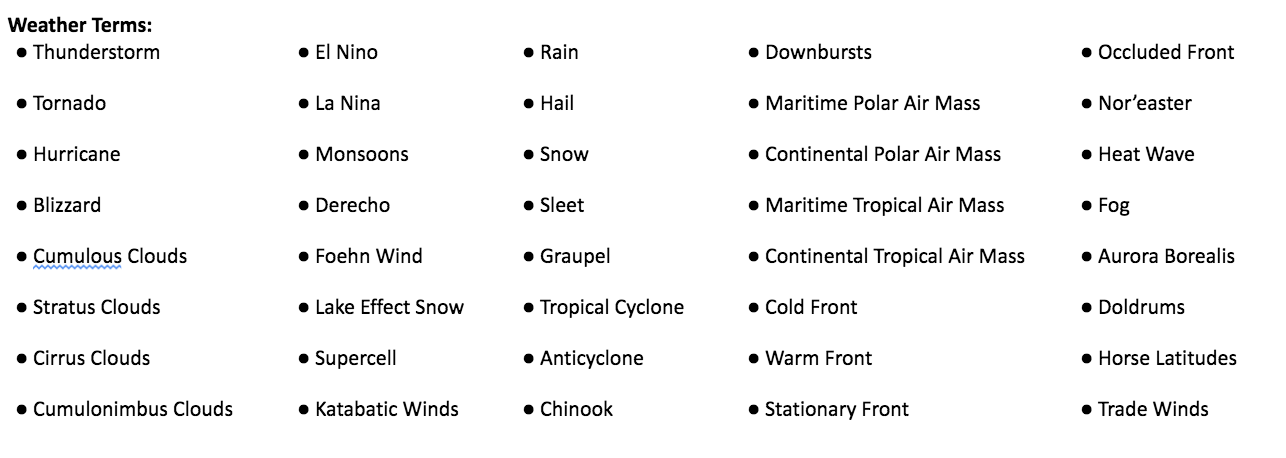- Author:
- Melody Casey
- Subject:
- Science
- Material Type:
- Lesson Plan
- Level:
- Middle School
- Grade:
- 7
- Tags:
- License:
- Creative Commons Attribution Non-Commercial
- Language:
- English
Education Standards
Recipes for Disaster! (AIG IRP)

Overview
Within the earth science strand of 7th grade science, students focus on understanding the cycling of matter in and out of Earth’s atmosphere. In this task, students will research five weather phenomena and use this information to create five “recipes for disaster” to be compiled for a class analysis for similarities and differences and a general understanding of the importance of temperature, pressure, and humidity in weather. The web/text research and result analysis, as well as the creative writing nature of this lesson, allow students to build content understanding while promoting 21st Century Skills. This lesson was developed by NCDPI as part of the Academically and/or Intellectually Gifted Instructional Resources Project. This lesson plan has been vetted at the state level for standards alignment, AIG focus, and content accuracy.
Lesson Overview
Brief Description of Lesson/Task/Activity: Within the earth science strand of 7th grade science, students focus on understanding the cycling of matter in and out of Earth’s atmosphere. In this task, students will research five weather phenomena and use this information to create five “recipes for disaster” to be compiled for a class analysis for similarities and differences and a general understanding of the importance of temperature, pressure, and humidity in weather. The web/text research and result analysis, as well as the creative writing nature of this lesson, allow students to build content understanding while promoting 21st Century Skills.
Time Frame: 3 class periods (~180 minutes)
Type of Differentiation for AIGs:
- Acceleration
Adaptations for AIGs:
- Process
- Product
Explanation of How Resource is Appropriate for AIGs: AIG students in the middle grades have been exposed to basic weather content throughout their elementary science courses. As a result, they are ready to perform individual weather phenomena research and understand its content with minimal teacher input. Once students have distilled these weather phenomena to their basic “parts,” they will also quickly arrive at a greater understanding of the role of specific factors in weather types. The creative writing aspect of this assignment will also allow AIG students to interact with the non-fiction information and demonstrate student understanding in a more interesting manner.
Needed Resources/Materials:
- Copy of “Recipe for Weather” for class viewing (see attached)
- List of weather phenomena
- Computer with internet and printing access
Sources: “Recipe for Weather” from http://eo.ucar.edu/webweather/basic.html
Teacher Notes: If students do not have experience with citing information sources, consider spending some time demonstrating where different pieces of this information can be found on various websites. Also, consider allowing all students to use a reference generator like “Son of Citation Maker” at http://citationmachine.net/index2.php to improve student compliance with citing sources. The teacher may also want to create a Word or Publisher template to be stored on the school’s student file drive if consistency of format is expected for student submissions.
Stage 1: Engage
DAY ONE:
Project the “Recipe for Weather” (see below) so that it can be viewed by the entire class. Read the recipe aloud. Point out the various parts of a standard recipe: the title (what is being made), the ingredients (what materials are needed), and the directions/procedure (how to combine the materials to get the final result). Ask students what is missing from this recipe example-- or any lab procedure in science class. Students should recognize that there are no specified amounts for the ingredients. Ask students why these ingredients would not have specific amounts included. Students should be able to explain that the variation in the amounts of these weather factor “ingredients” result in the different types of weather that we experience. Explain to students that they will be creating a class recipe book entitled “Recipes for Disaster” in which each student will have contributed five different weather phenomena recipes. Students will also be asked to provide a picture of the weather phenomena so that others can see the “final result” that is being made by following the recipe. Just as this recipe did not include ingredient amounts, other recipes may not include such numbers; however, if it is possible to be specific or provide a range of amounts, students should be encouraged to add those details.
Stage 2: Elaborate
Assign five of the following weather terms to each student in a group of four-five students. Students should document the use of at least three sites for each term to encourage research validation. As students begin their research, the teacher should be prepared to ask guiding questions such as: “What factors in the environment are required for that weather phenomenon to occur?” “Does this phenomenon occur more often in a particular area of the world? Why?” “Does this phenomenon occur more often during a certain time frame? Why?” “Does this phenomenon occur higher or lower in the troposphere?” “How do the weather factor ingredients combine—is there a diagram that shows this process?” “How does the movement of water through the hydrologic (water) cycle contribute to this phenomenon?”
DAY TWO:
Provide time for students to complete any remaining research and create their recipes with illustrations. Two copies of each recipe should be printed – one for teacher assessment use, one for class use in tomorrow’s culminating activity.
DAY THREE:
Hand out each group’s activity copies and allow those students to share them out or perform a “gallery walk” at their group to view and read them. Students within each group should be looking for and recording specific similarities and differences among their recipes. Students may even choose to physically classify or group recipes in different piles based on these similarities and differences. Students should also be looking for and recording broad commonalities across these groups.
Next, students should discuss as a class the similarities, differences, and patterns that they have seen. The teacher should guide the discussion as necessary to ensure that students understand the role of temperature, pressure, and humidity in weather.
Students should complete a ticket-out-the-door reflection for the activity using the question “What are the main factors in forming different types of weather and what examples can be used to support your reasoning?”
Stage 3: Evaluate
Student Reflections on the activity should be examined and assessed on the following scale:
4: student demonstrates an understanding of the role of temperature, pressure, and humidity in weather and provides several accurate and specific supporting details
3: student demonstrates an understanding of the role of temperature, pressure, and humidity in weather and provides some accurate supporting details
2: student demonstrates an understanding of the role of temperature, pressure, and humidity, but does not provide supporting details
1: student does not demonstrate an understanding of the role of temperature, pressure, and humidity and/or does not provide accurate supporting details
Student Recipes should be assessed using the following elements:
- Recipe contains a title indicating weather term researched
- Recipe contains accurate “ingredients” for the weather term, including any “amounts” possible
- Recipe contains accurate description of how “ingredients” combine to cause weather term
- Recipe contains appropriate illustration of “final result”
- Recipe contains accurate citation for at least three sources
- Grammar and spelling are appropriate for this grade level
